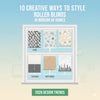Wooden Vertical Blinds: Natural Beauty Meets Practical Function
- by Giorgi Gogidze

When it comes to window treatments, wooden vertical blinds represent the perfect marriage of natural elegance and everyday practicality. These sophisticated window coverings bring the warmth and character of real wood to the functional advantages of vertical blind design, creating a solution that works beautifully in both traditional and contemporary homes. If you're seeking window treatments that offer more than just basic light control, wooden vertical blinds deserve serious consideration.
[toc]
The Appeal of Wood in Window Treatments
Wood has been a preferred material for home furnishings for centuries, and for good reason. Its natural grain patterns, rich textures, and warm tones create an inviting atmosphere that synthetic materials struggle to replicate. When applied to vertical blinds, wood brings these same qualities while maintaining all the functional benefits that make vertical blinds so popular for large windows and sliding doors.
Timeless Aesthetic Unlike trendy materials that may look dated in a few years, wood possesses a timeless quality that transcends decorating fads. Wooden vertical blinds can seamlessly transition through multiple design updates in your home, adapting to new color schemes and furniture while maintaining their classic appeal.
Natural Variation Each wooden vane is unique, with its own grain patterns and subtle color variations. This natural diversity creates visual interest and depth that uniform synthetic materials cannot match, adding character and authenticity to your windows.
Types of Wood Used in Vertical Blinds
Basswood
Basswood is the most common choice for wooden vertical blinds due to its light weight, smooth grain, and excellent staining properties. It's naturally pale, making it ideal for lighter stain colors and painted finishes. Basswood is also less prone to warping than denser hardwoods, making it practical for vertical applications.
Oak
Oak vertical blinds offer pronounced grain patterns and superior durability. The wood's natural strength makes it excellent for larger installations, though the weight can be a consideration for very wide windows. Oak takes stain beautifully, allowing for rich, deep colors that showcase the wood's natural character.
Cherry
Cherry wood provides a naturally warm, reddish tone that deepens with age and light exposure. Cherry vertical blinds are often considered a premium option, offering exceptional beauty with moderate weight and good stability.
Bamboo
While technically a grass rather than wood, bamboo is often grouped with wooden blinds due to its similar appearance and natural properties. Bamboo grows rapidly, making it an eco-friendly choice that offers unique grain patterns and natural sustainability.
Practical Advantages of Wooden Vertical Blinds
Superior Light Control
Natural Light Filtering Wood's organic nature allows it to filter light beautifully, creating a warm, diffused illumination that's more pleasing than the harsh light control of synthetic materials. When partially closed, wooden vanes create gentle shadows and interesting light patterns that enhance your room's ambiance.
Adjustable Privacy Like all vertical blinds, wooden versions offer excellent privacy control through vane rotation. The natural opacity of wood provides complete privacy when closed while still allowing you to angle the vanes for partial visibility and light when desired.
Temperature Regulation
Natural Insulation Wood is a natural insulator, helping to regulate indoor temperatures more effectively than thin synthetic materials. During winter, wooden vertical blinds can help retain warm air, while in summer, they provide better protection against heat gain through windows.
Energy Efficiency The insulating properties of wood can contribute to reduced energy costs by lessening the load on heating and cooling systems. This is particularly beneficial for large windows where energy loss can be significant.
Durability and Longevity
Built to Last Quality wooden vertical blinds are investments that can last for decades with proper care. Unlike synthetic materials that may fade, crack, or become brittle over time, well-maintained wood develops a beautiful patina that enhances its appearance with age.
Repairable and Refinishable One of wood's greatest advantages is its ability to be restored. Minor scratches can be sanded out, and the entire blind can be restained or refinished if you want to change colors or refresh the appearance years later.
Design Versatility
Stain and Finish Options
Natural Stains Clear and light stains allow wood's natural grain and color to show through while providing protection. These finishes work well in spaces where you want to highlight the wood's organic beauty.
Rich Colors Darker stains like walnut, mahogany, or ebony create dramatic, sophisticated appearances that work well in formal settings or rooms with bold design schemes.
Painted Finishes Some wooden vertical blinds can be painted, allowing you to match them precisely to your room's color scheme while still benefiting from wood's superior durability and insulation properties.
Complementary Design Styles
Traditional Interiors Wooden vertical blinds feel right at home in traditional settings, complementing hardwood floors, crown molding, and classic furniture pieces. They provide functional window coverage without disrupting the room's established character.
Contemporary Spaces In modern interiors, wooden vertical blinds can serve as a warming counterpoint to sleek surfaces and minimalist design. The natural material softens hard edges while maintaining clean, vertical lines that work with contemporary aesthetics.
Transitional Design For homes that blend traditional and contemporary elements, wooden vertical blinds provide the perfect bridge, offering classic material appeal with modern functionality.
Installation and Sizing Considerations
Weight Factors
Wooden vertical blinds are heavier than their synthetic counterparts, which requires careful consideration of mounting hardware and support. Professional installation is often recommended, especially for larger windows, to ensure proper support and smooth operation.
Vane Width Options
Wooden vertical blinds typically come in 3.5-inch or 4-inch widths. The wider option provides better coverage with fewer vanes, creating a cleaner appearance, while narrower vanes offer more flexibility in light control and can be more suitable for smaller windows.
Custom Sizing
Most quality wooden vertical blinds are made to order, allowing for precise fitting to your specific window dimensions. This customization ensures optimal appearance and function while accommodating any architectural quirks your windows might have.
Maintenance and Care
Regular Maintenance
Dusting Weekly dusting with a soft cloth or vacuum brush attachment keeps wooden vertical blinds looking their best. The natural antistatic properties of wood mean they don't attract dust as readily as some synthetic materials.
Periodic Cleaning Occasional cleaning with a wood-appropriate cleaner helps maintain the finish and protect the wood. Always follow manufacturer guidelines and test cleaning products on an inconspicuous area first.
Long-term Care
Humidity Considerations Wood responds to humidity changes by expanding and contracting slightly. While this is normal, extreme humidity fluctuations should be avoided. Using a whole-house humidifier or dehumidifier can help maintain stable conditions.
UV Protection While wood is naturally more UV-resistant than many synthetic materials, prolonged direct sunlight can cause fading or drying. Consider the sun exposure of your windows when selecting stain colors and finishes.
Cost Considerations
Initial Investment
Wooden vertical blinds typically cost more than synthetic alternatives, but this higher initial cost is offset by their durability, timeless appeal, and potential for refinishing. Consider them an investment in your home's long-term beauty and functionality.
Value Proposition
When compared to other natural window treatments like custom drapery or wood shutters, wooden vertical blinds often provide better value while offering superior functionality for large windows and sliding doors.
Long-term Economics
The ability to refinish and repair wooden vertical blinds means they can potentially last decades, making their cost per year of service very competitive with cheaper alternatives that need regular replacement.
Choosing the Right Wooden Vertical Blinds
Quality Indicators
Look for blinds made from solid wood rather than wood composites or veneers. Quality hardware, smooth track systems, and precision manufacturing are essential for long-term satisfaction, especially given the weight of wooden vanes.
Environmental Considerations
If sustainability is important to you, look for blinds made from responsibly harvested wood or rapidly renewable materials like bamboo. Many manufacturers now offer eco-friendly options without compromising quality or beauty.
Professional vs. DIY Installation
Given the weight and precision required for proper installation, professional installation is often worth the investment for wooden vertical blinds. Proper installation ensures smooth operation and prevents issues that could damage the blinds or your windows.
The Perfect Balance
Wooden vertical blinds represent the ideal compromise for homeowners who refuse to choose between beauty and function. They offer the practical advantages that make vertical blinds so popular for challenging window applications while providing the natural warmth and character that only real wood can deliver.
Whether you're dressing a wall of windows in a great room, covering sliding doors to a deck, or adding warmth to a contemporary office space, wooden vertical blinds provide a sophisticated solution that enhances rather than merely covers your windows. They prove that practical doesn't have to mean plain, and that functional can indeed be beautiful.
In a world of synthetic materials and disposable goods, wooden vertical blinds stand as a testament to the enduring appeal of natural materials and quality craftsmanship. They're not just window treatments – they're an investment in your home's character and your daily enjoyment of the spaces you love most.







